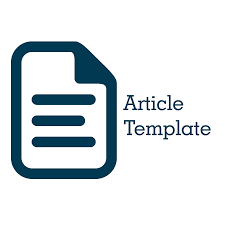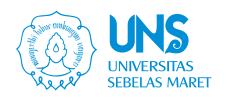Hubungan pemenuhan kebutuhan belajar dengan kemampuan pemecahan masalah peserta didik Sekolah Dasar
Abstract
This study investigated the correlation between the fulfillment of learning needs and students' problem-solving abilities in science instruction within elementary schools. The research was grounded in the urgency of 21st-century skills development, especially critical and problem-solving thinking, in response to the educational demands of the Industry 4.0 and Society 5.0 eras. A quantitative correlational survey design was applied. The population included elementary school students in Laweyan District. Data were gathered using a 4-point Likert-scale questionnaire to assess students’ perceptions of learning needs (readiness, interest, and learning profile) and open-ended questions to measure problem-solving ability (identification, alternative solutions, best solution implementation, and evaluation). Data were analyzed using Partial Least Squares Structural Equation Modeling (PLS-SEM) via SmartPLS 4. Findings revealed low but positive correlations between all aspects of learning needs and problem-solving skills. Readiness had the strongest correlation with generating alternative solutions (r = 0.220), while interest was most strongly linked to executing the best solution (r = 0.217). Learning profile showed the weakest associations across all indicators. The results emphasized that although learning needs are not dominant predictors, their integrated fulfillment contributes to improving problem-solving competence. The study concluded that comprehensive attention to students’ learning readiness, interest, and learning profiles supports the development of their problem-solving abilities.
Keywords
References
Kahar, M. I., Cika, H., Nur Afni, and Wahyuningsih, N. E. 2021. Moderasi: Jurnal Studi Ilmu Pengetahuan Sosial 2, 58–78. https://doi.org/10.24239/moderasi.vol2.iss1.40 Tahar, A., Setiadi, P. B., Rahayu, S., and Stie, M. M. 2022. Jurnal Pendidikan Tambusai 6, 12380–12381. Alwanda, R. I., Alviasyah, E. N., Lailatul, S. F., and Jariyah, I. A. 2024. Jurnal Pendidikan 2, 44–50. Malik, A., Dirgantara, Y., Mulhayatiah, D., and Agustina, R. D. 2020. Conference & Workshop UIN Sunan Gunung Djati 1, 1–12. Caraan, D. R., Dinglasan, J. K., and Ching, D. 2023. International Journal of Education Management and Development Studies 4, 64–87. World Economic Forum 2016. Ten 21st-century skills every student needs. https://www.weforum.org/stories/2016/03/21st-century-skills-future-jobs-students/ Khoiriyah, A. J., and Husamah, H. 2018. JPBI (Jurnal Pendidikan Biologi Indonesia) 4, 151–160. https://doi.org/10.22219/jpbi.v4i2.5804 Romanti, S., and Rohita, R. 2021. Jurnal Anak Usia Dini Holistik Integratif (AUDHI) 3, 1. https://doi.org/10.36722/jaudhi.v3i1.587 Anggarwati, H., and Alfiandra, A. 2023. Jurnal Pendidikan dan Konseling 5, 5572–5575. Safitri, N., Safriana, S., and Fadieny, N. 2023. Jurnal Pendidikan dan Ilmu Fisika (JPIF), 246–255. Farid, I. 2022. Jurnal Pendidikan dan Konseling 4, 1707–1715. Maulidia, F. R., and Prafitasari, A. N. 2023. ScienceEdu 6, 55. https://doi.org/10.19184/se.v6i1.40019 Naibaho, D. P. 2023. Jurnal Creative Student Research 1, 81–91. Isrotun, U. 2022. STEKOM Proceedings 2, 1–10. Heacox, D. 2017. Making differentiation a habit: How to ensure success in academically diverse classrooms, 2nd ed. Free Spirit Publishing. Hidi, S., and Renninger, K. A. 2006. Educational Psychologist 41, 111–127. https://doi.org/10.1207/s15326985ep4102_4 Tomlinson, C. A., and Imbeau, M. B. 2010. Leading and managing a differentiated classroom. ASCD. Hair, J. F., Hult, G. T. M., Ringle, C. M., and Sarstedt, M. 2021. A Primer on Partial Least Squares Structural Equation Modeling (PLS-SEM), 3rd ed. SAGE Publications. Wong, K. K. K. 2013. Marketing Bulletin 24, 1–32. Vygotsky, L. S. 1978. Mind in Society: The Development of Higher Psychological Processes. Harvard University Press. Deci, E. L., and Ryan, R. M. 2000. Psychological Inquiry 11, 227–268. https://doi.org/10.1207/S15327965PLI1104_01 Dunn, R., and Dunn, K. 1993. Teaching Secondary Students Through Their Individual Learning Styles: Practical Approaches for Grades 7–12. Allyn & Bacon. Zimmerman, B. J., and Moylan, A. R. 2009. In Handbook of Metacognition in Education, edited by D. J. Hacker, J. Dunlosky, and A. C. Graesser, pp. 299–315. Routledge. Ningsih, N. L. P. Y. W., and Suniasih, N. W. 2020. Mimbar Ilmu 25, 367–379. Alwiyah, D., and Imaniyati, N. 2018. Jurnal Manajerial 17, 95–103. Fitriyani, S., Supriatna, A., and Suryana, D. 2022. Jurnal Pendidikan Sains Indonesia 10, 245–254. Sukma, F., F., P., Chamdani, M., and Susiani, T. S. 2022. Kalam Cendekia: Jurnal Ilmiah Kependidikan 9. https://doi.org/10.20961/jkc.v9i3.53035 Schiefele, U., Schaffner, E., Möller, J., and Wigfield, A. 2016. Learn Instr 44, 1–10. https://doi.org/10.1016/j.learninstruc.2016.02.002 Aftriyati, L. W., Roza, Y., and Maimunah, M. 2019. Jurnal Matematika, Statistika Dan Komputasi 16, 226. https://doi.org/10.20956/jmsk.v16i2.8515 Hermaini, J., and Nurdin, E. 2020. JURING (Journal for Research in Mathematics Learning) 3, 141–148. Schunk, D. H., Pintrich, P. R., and Meece, J. L. 2014. Motivation in Education: Theory, Research, and Applications, 4th ed. Pearson. CAST 2018. Universal Design for Learning Guidelines version 2.2. Wakefield, MA. https://udlguidelines.cast.org/ Tomlinson, C. A. 2001. How to Differentiate Instruction in Mixed-Ability Classrooms, 2nd ed. ASCD Romadhina, L., and Ruja, I. N. 2024. Jurnal Integrasi dan Harmoni Inovatif Ilmu-Ilmu Sosial 4, 10. https://doi.org/10.17977/um063v4i7p10 Koç, H., and Baran, M. 2021. Int J Educ Methodol 7, 267–278. https://doi.org/10.12973/ijem.7.2.267 Kumala, F. N., Yasa, A. D., Salimi, M., Hidayah, L., and Chusniyah, D. A. 2024. Data Metadata 3, 591.
Refbacks
- There are currently no refbacks.



